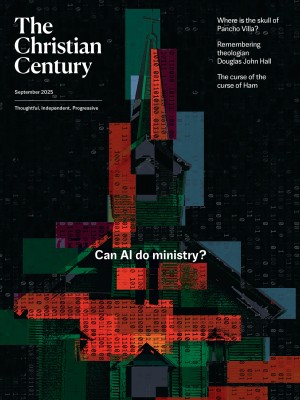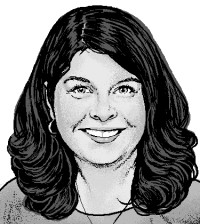The rise and fall of children’s Sunday school
Faith formation isn’t dead. It’s happening outside the classroom.

Photo by LumiNola / E+ / Getty
Much of my upbringing took place in Sunday school rooms. We spent a lot of time at church when I was growing up in the 1970s and ’80s. I was baptized in one United Church of Christ congregation, confirmed in another, and spent some time at my grandmother’s Evangelical Free church as well. In all three churches, the Sunday school rooms were off corridors in a dedicated wing. In my memories, those rooms and corridors are all about the same. The floors are speckled tile—possibly asbestos, I realize now—with a vinyl baseboard. The walls are cinder block painted in pale yellow, blue, mint green, or off-white. A rug designates the space for the Bible story circle time, which includes the beloved felt board for illustrating the stories with people and animals and a rainbow for Noah’s ark. Chairs and tables are placed on the tile floor for crafts and activities. Posters from the denominational curriculum hang on the walls, depicting little children gathered around Jesus. There are Dixie cups for grape or apple juice, served with animal crackers or, later, Goldfish. Many of my colleagues have strikingly similar memories, right down to the particular smell, a mix of the paint on the cinder blocks and the cleaning solutions used on the floors.
We heard and memorized scripture in those rooms. We made endless crafts—tangentially related to the day’s Bible verses—of Popsicle sticks, paper plates, pipe cleaners, tissue paper, glitter, and glue. We sang songs, learned hymns, memorized the Gloria Patri and the Doxology and the Lord’s Prayer. We knew that Jesus loved us. We knew that here is the church and here is the steeple. We dressed for Christmas pageants in those rooms and wore our Easter finest after weaving Palm crosses the week before. After class we’d proceed to the sanctuary to sit with our parents or grandparents during the worship service.
Read our latest issue or browse back issues.
These Sunday school wings emerged in the 1950s and ’60s in response to the baby boom. At my grandmother’s church, the 1920s-era stone building was equipped with a Sunday school addition by the 1950s. The church where my parents were married was a newly planted congregation of the newly merged UCC, built in the late 1950s. Not even a decade later, more space was needed. My father served on the capital campaign committee to raise funds for the Sunday school wing, which was complete by the time we were born. The UCC church we joined later, when we moved across town, had relocated from a downtown location to a growing neighborhood, also in the late 1950s. This building was constructed with the Sunday school wing already included.
These wings were necessary to accommodate the families streaming into churches in those days to get their children the scriptural and moral instruction characteristic of Sunday schools in that era. The curricula grew out of the US expression of the Sunday school movement, which arose at the turn of the 20th century. Individual classes were by grade level, mimicking the public schools. The format of the lessons was largely repetitive and emphasized learning by rote.
By the early 1990s, churches were getting more creative. They used the rotation model, multiple intelligences curriculum. As a newly ordained associate pastor I implemented the Montessori-inspired Godly Play curriculum in the church I was serving. Curricula kept progressing, but attendance regressed all the same. Fewer children were being born, and even fewer were going to church. Today those Sunday school rooms are no longer teeming with children, who, along with their parents, are either on sports fields or simply elsewhere, nowhere near a church on Sunday.
My current ministry involves visiting congregations. They are asking what failed in their curriculum or church life. After their efforts to adapt, with program after program, the empty classrooms haunt them. It’s hard for them to hear that they are swimming against big cultural and demographic tides. Pastors are trying to figure out what to do with their Sunday school space: rent it to preschools, repurpose it for offices for nonprofit ministries or arts or after-school programs, use it for evening shelter for the unhoused. Or in some cases, raze the Sunday school building and sell off that portion of the property.
Those Sunday school wings were built at the height of American church attendance thus far. It was the spike in the curve, not the overall norm. There are plenty of churches that are now ahead of the curve and yet feel far behind it, because the curve itself has leveled. It is hard to remind people witnessing a death that there will be resurrection. It took a while for the disciples to believe it, too. What the resurrection looks like is already becoming apparent in other parts of the world. In the United States, it may involve a faithful remnant of congregations, not every particular local church and its Sunday school wing. I see it happening on the “praygrounds” springing up in sanctuaries where it has occurred to someone that children learn to worship by attending worship, not by being sent out to Sunday school during the worship hour. I see it happening in multiage classrooms where the elders guide and the confirmands assist and the parents, who need formation themselves, are free to go to their own class.
I often say that when I retire, I want to run a Sunday school. I’ll do it for free, and I’ll do it with whatever is left—in a corner of the fellowship hall, in the back of the narthex, or in one of those aging Sunday school rooms, where I’ll gather just a few children on that rug and maybe even pull out the flannel board instead of a VeggieTales video. We’ve got centuries of Christian formation up our sleeve for the few or the many who may gather. We will be able to share the gospel whether or not there is a Sunday school wing.






